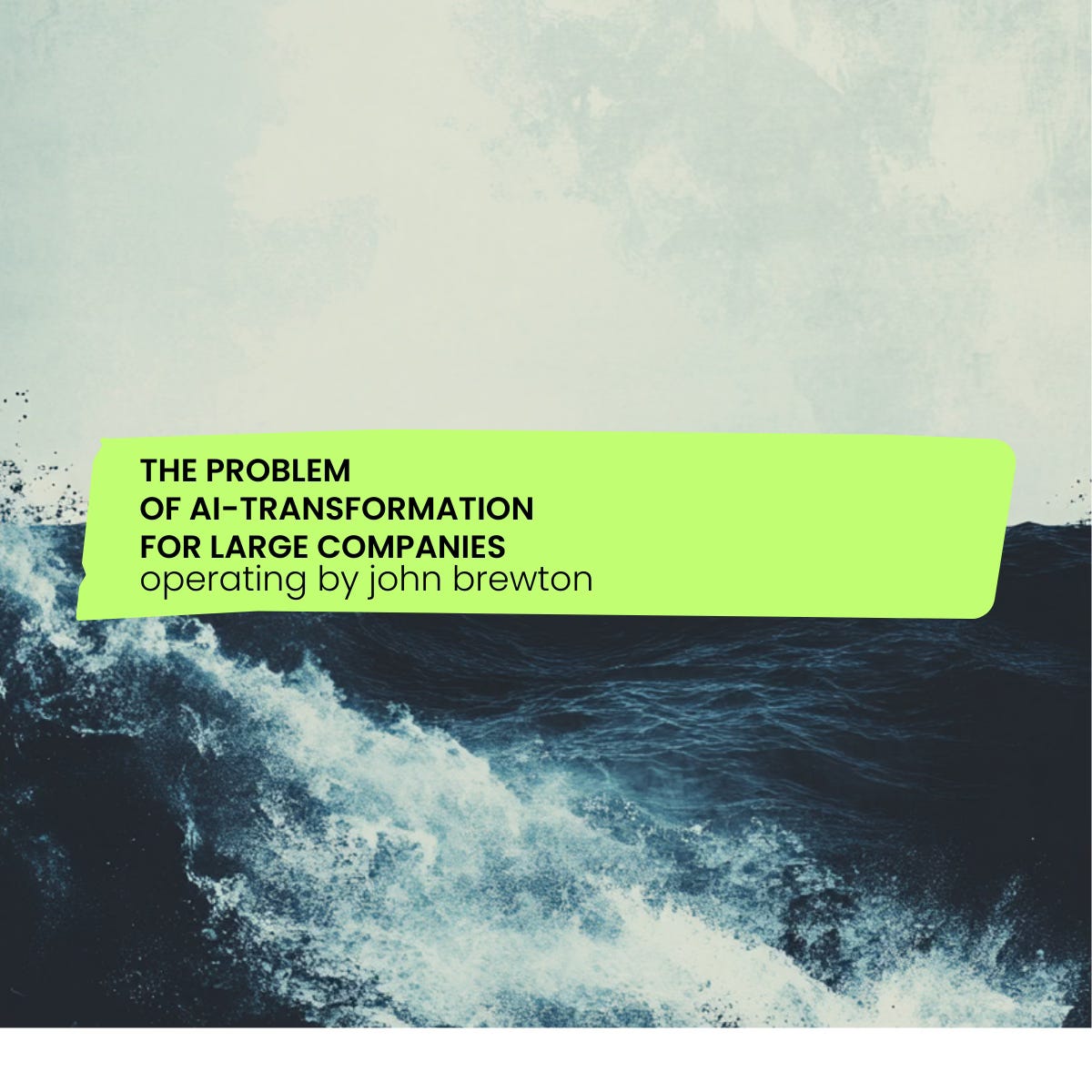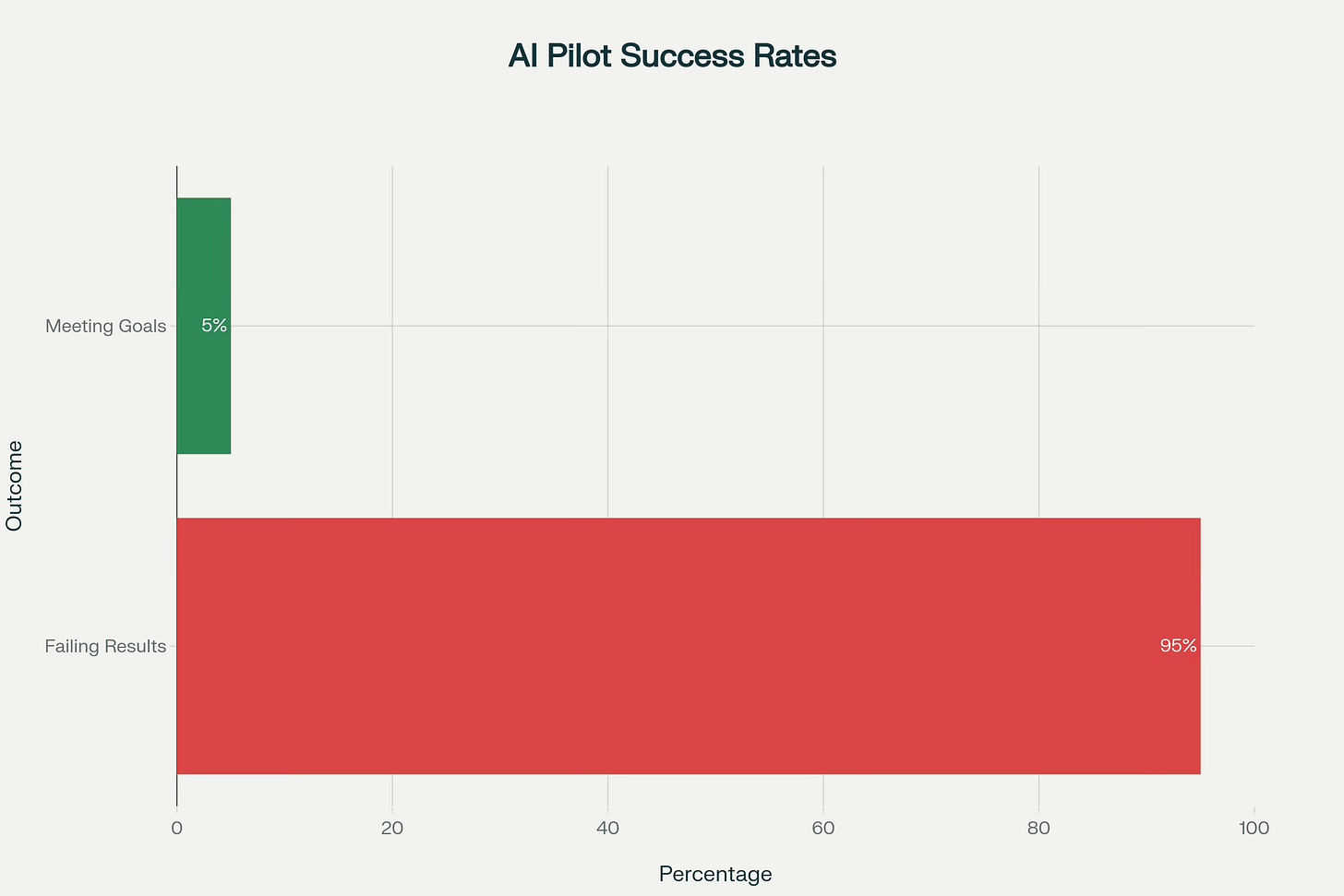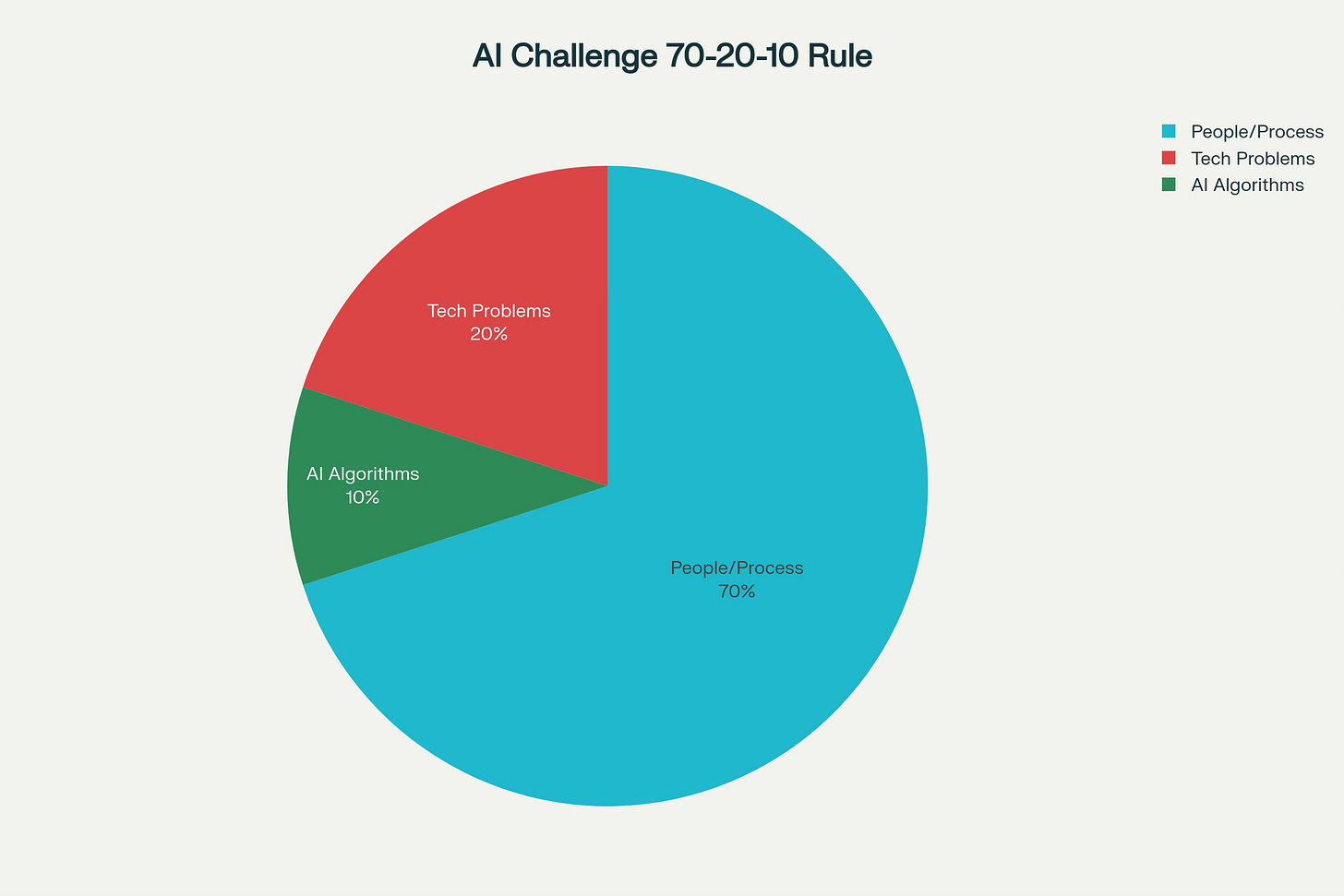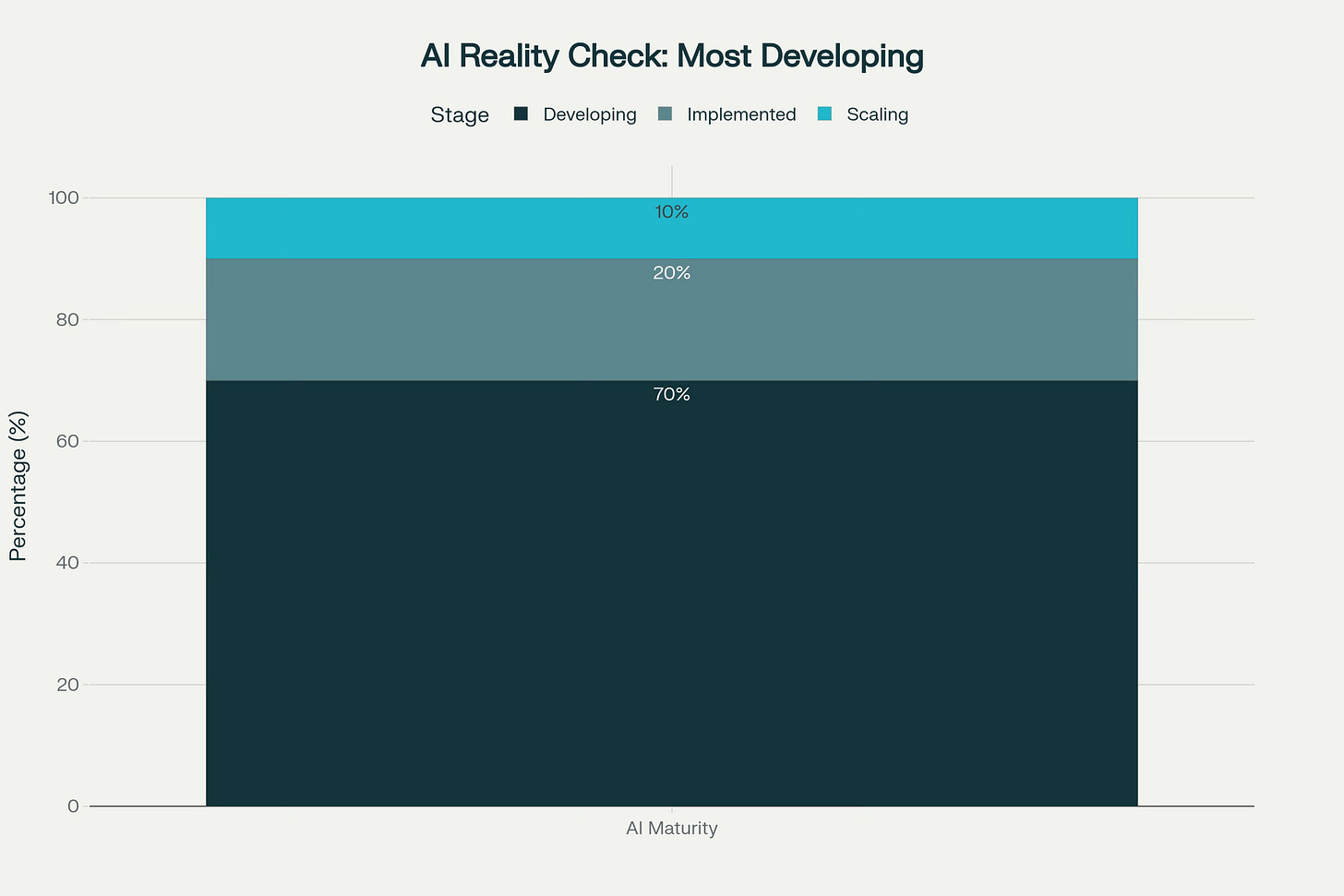The Problem of AI-Transformation For Large Companies
Why Large Organization Are Struggling With AI Transformation and Why They Must Learn to Succeed
The much discussed MIT NANDA study reports that 95% of generative AI pilots fail to move into production, underscoring a deep execution gap in enterprise AI. McKinsey finds a similar pattern, with 70% of initiatives stuck in development or expansion even after a year. Abandonment rates are rising, from 17% of projects in 2024 to 42% in 2025, and only 5–10% of companies managing to scale AI successfully. These numbers frame one version of our current reality for large companies: despite market hype and investment, most AI transformation efforts in large organizations are faltering long before delivering measurable impact.
This problem is existential for these firms. It is a problem that must be solved.
Bifurcated Outcomes
For any company trying to transform its current state to a more optimal version, change and its management is not uniform. The same tools produce different results depending on company size. In small companies, automation means avoiding hires. Efficiency gains become early growth engines. In large companies, the same efficiency implies redundancy and cost reductions. Gains are read as layoffs.
This split matters. Startups adopting best in class technology and operational practices, drive efficiency, keep headcount lean, achieve better unit economics, and scale faster from day one. Larger companies achieving the same productivity outcomes face cultural resistance, job security concerns, and political obstacles. Adoption becomes slow, partial, or abandoned.
The competitive consequence is significant. Historically, new technologies have favored incumbents with capital and infrastructure: electricity, railroads, and enterprise software. With AI, the order could reverse. Startups can embed the capacity from the ground up, becoming AI native from day one. Large companies must retrofit systems and retrain organizations. Their size, complexity and hierarchical rigidity create more work than is harder to perform.
This inversion should allow smaller players a competitive window to outpace the incumbents. We are living in that window.
Shifting Unit Economics
AI reshapes cost structures. A startup with 10 employees can run processes that once required 30. Instead of hiring, they expand output with the same team. Headcount remains steady, margins widen, and scalability improves. Moreover, the talented teams inside the organization are never introduced to the anxiety-ridden turbulence that accompanies concerns about redundancy, cost cutting and layoffs.
In larger firms, automation eliminates existing roles. An efficiency gain in accounts payable, customer service, or IT signals downsizing. The cultural cost is increased anxiety. Employees resist adoption if it feels like a threat to their livelihoods. Managers stall initiatives to protect their jobs and those of their teams.
This dynamic creates a market asymmetry:
Startups scale without disruption.
Large firms struggle to adapt.
This shift alters competitive dynamics. In past adoption waves, incumbents held the advantage. Enterprise resource planning (ERP), for example, required capital investment and integration talent. Cloud computing started to shift this dynamic, favoring startups that could build without legacy infrastructure.
AI builds on this trend, serving as an accelerant.
Clayton Christensen’s disruption framework applies. Incumbents protect existing processes and markets. Startups exploit operational advantages to undercut on cost or agility (in Five Forces speak, these attributes become new points of differentiation). The AI-enabled startup does not need a large back office, or middle management infrastructure to direct the workflow and priorities of the company. The economics of scale will favor lower headcount, cost-optimized organizations. This shift will also give small market participants the pricing power the have historically lacked when doing battles with incumbents.
Failure to Launch
MIT NANDA study: 95% of generative AI pilots fail to move into production.
McKinsey: 70% of initiatives remain stuck in development or expansion after one year.
Abandonment: 17% of projects abandoned in 2024; 42% abandoned in 2025.
Scaling success: Only 5–10% of companies successfully scale AI.
The numbers illustrate the gap between ambition, public discord and execution. Companies are running pilots and issuing press releases but failing to embed the tools up and down their value chains.
The clinical reality is sector-specific:
Healthcare: Studies show AI performs on par with human clinicians in diagnostics, but adoption lags. Trials stall over workflow integration, liability, and regulation.
Financial services: Risk, compliance, and regulatory pressure slow deployment. Banks run AI in sandboxes but hesitate to scale.
Retail and logistics: AI adoption is faster in narrow, structured tasks (inventory forecasting, route optimization) but slower in customer-facing or judgment-heavy roles.
The data shows enthusiasm, but also attrition.
Most firms cannot convert pilots into operating gains, YET.
People, Process, Resistance
If technology were the only barrier to AI adoption, transformation would be far easier. Instead, the largest obstacles lie in people and processes. The research makes this unavoidably clear. In the MIT NANDA study, McKinsey’s surveys and BCG’s research, the consistent theme is that organizations do not fail because they lack models or tools, they fail because their people and structures are not aligned with the change.
One of the most visible barriers is fear. In large companies, efficiency gains from AI are often interpreted as headcount reductions. Employees see automation as a direct threat to their jobs, and this perception creates resistance at every level of adoption. Where startups and small organizations simply avoid new hires as automation increases their capacity, large companies must contend with existing teams who fear being replaced. This cultural tension, as the MIT report highlights, can undermine even well-designed pilot programs. AI projects stall not only because of technical shortcomings, but because the workforce resists their implementation.
Research from Boston Consulting Group (BCG) highlights how people-related barriers remain the single greatest obstacle to AI adoption. In their surveys, nearly 70% of executives cite employee resistance as a leading reason initiatives stall, often ranking higher than technical or financial constraints. BCG attributes this resistance to two overlapping dynamics: fear of job loss, where automation is viewed primarily as a path to headcount reduction rather than skill augmentation, and uncertainty about role evolution, as employees struggle to envision how their work will look in an AI-embedded future. The report emphasizes that without clear communication, reskilling pathways, and leadership commitment to positioning AI as augmentative rather than eliminative, organizations risk reinforcing the culture of anxiety that drives abandonment. In short, BCG shows that the critical barrier to scaling AI is not the technology’s immaturity, but the workforce’s hesitation to trust that adoption will create opportunity rather than erode security.
Beyond fear, there is the issue of skills. McKinsey finds that fewer than one in four employees in large organizations feel they have adequate training to integrate AI into their daily work. At the executive level, adoption is often overstated. Many leaders claim their organizations are embracing AI, but in practice usage is shallow, limited to experiments with ChatGPT or Gemini for small tasks rather than the embedding of AI across workflows. This gap between perception and reality means that when pilots move toward production, teams are ill-prepared to absorb the tools into real processes.
Process discipline is another major shortfall. Research shows that 42% of AI projects abandoned in 2025 failed not because of poor models but because companies lacked the structures to integrate AI into production environments. Data governance, model monitoring, feedback loops, and cross-functional ownership remain underdeveloped. Organizational learning, not technical breakthroughs, is the missing ingredient. Without systematic feedback cycles, projects cannot mature beyond experimentation.
These people and process challenges are compounded by communication failures. Executives often assume that AI strategies are well understood across the organization, but surveys indicate most frontline employees are uncertain about both the purpose and the value of AI initiatives. The result is a disconnect: executives push for transformation, while employees view the initiatives as confusing or threatening. This dynamic contributes directly to the failure rate of generative AI pilots, creating the “adoption trust gap.”
In short, AI transformations struggle inside large organizations not because of inadequate technology but because of human and organizational realities. Fear of job loss, lack of training, shallow adoption, weak governance, and poor communication combine to stall initiatives before they scale. Until these people and process barriers are addressed, the statistics around failure and abandonment are unlikely to improve.
The Trust and Learning Gap
Accuracy is an additional top concern cited by employees. But research shows it is overstated.
Many workers have not used AI extensively. Concerns stem from perception more than data. They compare AI outputs to an imagined human standard of perfect accuracy, not actual error rates.
Human work is imperfect but normalized. AI errors are visible and judged harshly. This is visibility bias: errors from machines stand out, errors from humans fade into the background.
AI does make mistakes, but so do people. The real issue is designing systems to capture errors, not assuming human baselines are flawless.
Adoption is also often overstated.
Employees say they use AI, but most use it lightly: ChatGPT queries, email drafting, and productivity hacks. This is experimentation, not transformation.
True adoption requires embedding AI into workflows and systems of record. That means redesigning processes, retraining staff, and altering incentives. Fewer people than claim to be are actually going that far. Organizations thus share the same characteristic.
The MIT research calls this the learning gap. Individuals learn to use tools, but organizations fail to institutionalize them. McKinsey confirms: 70% of initiatives remain in early stages. As firms push deeper, abandonment rises.
This illusion creates a disconnect. Executives report AI adoption, but measurable gains are absent. Eventually this will become a problem that investors and stock prices provide the impetus to change, but it speaks to a new type of anxiety within companies. AI transformation won’t only be managing the work of entry-level employees; it will be taking over the desks of managers, directors, and decision-makers at more senior levels than prior technological revolutions.
What Progress Looks Like
Despite the high failure rates and widespread abandonment of AI projects, some companies are beginning to show what successful adoption looks like. The clearest examples come from Big Tech itself, though even here the stories are not straightforward. Microsoft, Google, and Meta each illustrate different approaches to embedding AI, and their progress aligns closely with the themes that appear in the research: structured change management, organizational rewiring, and a willingness to work through long time horizons.
Microsoft has approached AI transformation with discipline and pragmatism. Instead of dropping Copilot into every team at once, the company rolled it out in carefully managed phases. According to reporting on their internal process, Microsoft designated “champions” inside teams to model behavior and encourage colleagues to test the new tools. IT was heavily involved from the beginning, ensuring that governance and data security were not an afterthought. This reflects one of the research findings that vendor partnerships and formalized governance increase the odds of scaling success: companies with structured vendor engagement succeed 67% of the time, compared to 33% when they try to go it alone. Microsoft’s Copilot rollout shows how success is tied less to the technology itself and more to the organizational scaffolding around it.
Google has focused its strategy on building “agentic architectures.” Rather than positioning AI as a standalone product, Google has embedded it into its existing services and is simultaneously developing enterprise-ready agent stacks with memory, orchestration, and workflow tools. This dual approach, product integration on one side, organizational rewiring on the other, demonstrates a recognition that adoption requires both customer-facing and internal change. The research confirms that adoption succeeds when AI is embedded into systems of record rather than treated as a side experiment, and Google’s approach shows how an incumbent can take its scale and use it to make AI invisible but indispensable inside workflows.
Meta, by contrast, has treated AI adoption less as an incremental change and more as an organizational reset. Internal reporting indicates that Meta has deliberately restructured teams around AI development, prioritizing cost discipline in its legacy business lines in order to free up resources for AI scaling. This aligns with the finding that AI transformation often requires “organizational rewiring” rather than surface-level adoption. Meta’s approach echoes the research’s warning that companies spend too much time on infrastructure and too little on people and processes. By reorganizing its teams, Meta is trying to reverse that imbalance, even at the cost of internal disruption.
Among the companies studied, Meta stands out as the clearest example of how AI transformation succeeds when it is treated as an operating model redesign rather than a technology project. Unlike peers who struggle to move pilots into production, Meta has embedded AI into the core of its organizational fabric. Its success comes from reframing AI as an engine for execution, not just efficiency. Meta reorganizes teams, restructures workflows, and redefines performance measures around AI’s capabilities, ensuring that adoption is not a bolt-on experiment but a systemic shift. This makes Meta’s approach especially compelling: it acknowledges that for AI to deliver at scale, a company must adapt how it operates, organizes, and executes to align with the technology’s strengths.
Google, by contrast, demonstrates the power of capacity and scale as a different, but equally important, pathway. Rather than reorganizing its operating model to the same degree as Meta, Google leverages the strength of its infrastructure and research dominance. The company’s frontier models, its integration of Gemini into consumer and enterprise products, and its ability to embed AI across Search, Cloud, and Workspace illustrate how deep technical resources can accelerate transformation. Where Meta shows the importance of reshaping organizational execution, Google shows that transformation can also be achieved by harnessing AI’s scale and embedding it into products that already command global distribution.
Taken together, the two cases illustrate the dual dimensions of AI transformation: Meta proves that operating models must evolve, while Google proves that technical capacity and integration can generate competitive advantage at scale.
These case studies highlight the larger truth in the research: success comes less from algorithmic breakthroughs and more from how companies structure their organizations. Microsoft’s managed rollouts, Google’s agentic architectures, and Meta’s structural rewiring are all examples of how incumbents can push through the barriers. They also illustrate the point that AI transformation is long-term work. Each company has had to accept costs, disruption, and experimentation in exchange for embedding AI into its core systems.
The Scale of AI Investment: CapEx at Record Highs
The capital commitments made by the largest technology companies underscore both the urgency and cost of AI transformation. Microsoft projects $80 billion in FY 2025 CapEx, a 50% increase from the $53 billion spent in 2023, largely directed toward AI-enabled data centers, Azure expansion, and embedding AI across its product suite. Importantly, much of this investment is intended for internal transformation, modernizing Microsoft’s own processes and services—rather than simply resale to cloud customers. Google (Alphabet) is set to exceed even this, with $85 billion in 2025 CapEx, of which roughly two-thirds is dedicated to custom AI servers (TPUs and GPUs) and one-third to data centers and networking. This allocation fuels Google Cloud, Gemini, Vertex AI, and the AI saturation of search and ads, supported by the fact that 15% of Alphabet’s R&D budget is now directed at AI initiatives. Meta is pursuing a similar trajectory: after spending $37.26 billion in 2024 (+36.6% YoY), largely on GPU clusters, data centers, and a $14.3 billion acquisition of Scale AI, the company now forecasts $65–72 billion in 2025 CapEx, leaning toward the upper end. Much of this spend builds infrastructure for Meta Superintelligence Labs and drives AI integration into its platforms, from ad automation to internal workflows. The scale of these investments makes clear that AI transformation is not incremental; it is a capital-intensive restructuring of how these firms intend to operate, compete, and define the future of their industries.
What Large Companies Must Do
The research makes one point unmistakably clear: technology alone does not drive transformation. Companies that succeed at embedding AI do so because they treat adoption as an organizational challenge, not a technical one. The evidence shows that most firms continue to overspend on infrastructure and underspend on people and processes, which explains why nearly half of pilots never scale. A credible path forward requires reversing that imbalance.
The first step is for executives to reallocate budgets and attention. Much energy has necessarily gone into standing up technical infrastructure, data lakes, APIs, model procurement, while the change management side of the ledger has been less discussed. Training, governance, and workflow redesign are not secondary tasks; they are the central work of AI adoption. Without them, the most advanced model is destined to sit idle. This is why companies that engage vendors and implementation partners strategically see double the success rates of those that try to self-manage transformation.
The second step is to reframe how AI is introduced. The research shows that adoption gains traction when organizations start with back-office automation, where workflows are structured, risks are lower, and ROI is easier to measure. Success in payroll reconciliation, expense reporting, or IT ticket resolution builds both confidence and cultural buy-in. By contrast, beginning with highly visible customer-facing applications, where mistakes are obvious and the stakes are higher, often backfires, reinforcing employee resistance and management skepticism.
Equally important is the narrative that leaders build inside their organizations. Employees must see AI as augmentation, not replacement. Fear of job loss remains one of the primary barriers identified in the research, with as many as 23% of workers citing it as their top concern. When leaders communicate that AI is meant to remove low-value tasks and open space for higher-value work, adoption becomes a cultural shift rather than a zero-sum battle over headcount. Microsoft’s use of Copilot champions demonstrates how peer influence and visible role models can accelerate this cultural acceptance.
Executives must also recognize that AI transformation is a timeline measured in years, not quarters, a difficult reality to accept when stock performance is as strongly tied to these project as is currently the case. The research on abandonment rates makes this plain: nearly half of projects that begin in pilot never scale, and those that do often take two to three years to reach maturity. Companies that set unrealistic expectations for immediate impact typically end up cutting projects before they have the chance to produce results. Patience is not optional, it is the price of transformation.
Finally, leaders need a framework for accountability. A practical checklist emerges from the research:
Communicate strategy clearly and repeatedly.
Redesign workflows rather than layering AI on top of broken processes.
Track metrics that measure scaling instead of pilot activity.
Build adoption champions into every major team.
This is not a matter of managing technology but of orchestrating people, processes, and incentives in a coordinated way.
The path forward is demanding, but the alternative is worse. Startups are already structuring themselves with AI-native workflows, which means they scale without hiring and compete with efficiency advantages incumbents will struggle to match. Large companies that fail to take AI transformation seriously, and fail to manage it at the organizational level, are not just delaying progress. They are putting their long-term competitiveness at risk.
The story here is not that AI is failing to transform large companies, it’s that the task of achieving the transformation is uniquely more challenging for enterprises that have already achieved scale.
Closing: The Real Risk
The is not a story about algorithms and machine learning, it is about a real struggle for human organizations to accept the need for foundational change. Startups and small companies are taking advantage without triggering fear. They use AI to avoid new hiring, scale operations, and expand margins, all while building cultures where adoption feels natural rather than threatening. For them, AI transformation means growth, increased capital to reinvest, and more competitive positioning against the Goliaths of their markets.
Large companies experience the same tools very differently. Efficiency looks like headcount reduction, and that perception breeds resistance. Employees view automation as a threat to job security, and managers hesitate to push adoption too hard for fear of destabilizing their teams. The research confirms this dynamic and less than one in five companies communicates a clear AI strategy. In this environment, pilots stall, projects are abandoned, and transformation efforts collapse under the weight of internal resistance.
Smaller firms are leveraging AI to reshape their unit economics. They need fewer employees to produce more output, which means they can undercut incumbents on cost while scaling faster. This is not a temporary advantage; it is a structural one. For large companies, the consequence of slow adoption is long-term erosion of competitiveness.
Accuracy concerns and limited actual use compound the problem. Employees overstate their actual engagement with AI. They understate how often human work is inaccurate without AI. This double misperception makes AI feel riskier than it is and makes adoption feel more widespread than it really is. The reality is that transformation requires embedding AI into workflows and systems of record, not just using it at the margins.
The risk, then, is not that AI will replace too many jobs too quickly. The risk is that large companies, in trying to protect jobs and avoid disruption, will fail to transform at all. That failure will leave them competing against AI-native organizations that operate with radically better cost structures and cultural alignment. To fail is existential.
Successful adoption requires more than technical investment. It requires cultural rewiring, process redesign, and sustained executive commitment. The companies that recognize this will channel the disruption we are all experiencing it into long-term advantage.
Those who do not will find that the danger was never the technology itself. The danger was the very human decision to stand still.
John Brewton documents the history and future of operating companies at Operating by John Brewton. He is a graduate of Harvard University and began his career as a Phd. student in economics at the University of Chicago. After selling his family’s B2B industrial distribution company in 2021, he has been helping business owners, founders and investors optimize their operations ever since. He is the founder of 6A East Partners, a research and advisory firm asking the question: What is the future of companies? He still cringes at his early LinkedIn posts and loves making content each and everyday, despite the protestations of his beloved wife, Fabiola, at times.











Good read.
Working for a fintech that has to an extent adapted AI in workflow.
Noted higher productivity.
No proper training and ofcos no cushion for job maintainance so process abit slowed down.The bigger picture for the business with AI, quite promising.
The fear of job loss real, but i think better approach would be when function moves where else would one be best placed...
i would not hesitate to apply it in my business...so when i think like that, i worry less on what my boss(who is running their business would do)
More logic than emotions.